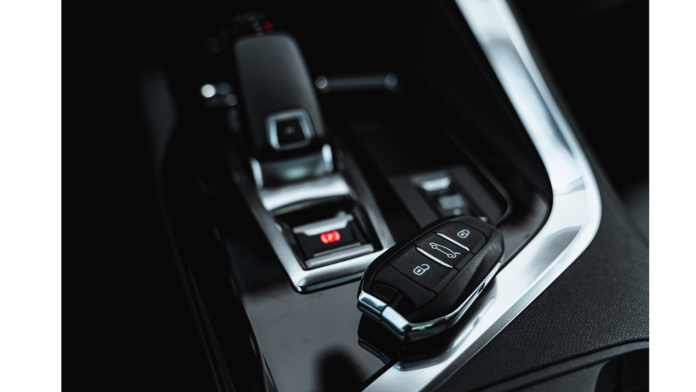The ordinary everyday key is a device we use every day yet have little idea how it works. The key is an implement we constantly see and are very familiar with, yet we hardly notice it until we have to use it.
Humans have a long history of using keys, and the first references to keys are over 4,000 years old, appearing in ancient Egyptian writings. As humans further developed the concept of personal property and ownership, we needed something to keep our property secure and out of the hands of others. This need led to the invention of locks and keys.
Over the years, particularly in the 20th and 21st centuries, keys have developed from simple cut metal keys; to intricately cut laser, transponder, and smart keys.
In this article, you will find everything you need to know about transponder keys, including what they are, how they work, and their advantages and disadvantages.
What are Transponder Keys?
A transponder key or chipped key is part of a transponder system. The transponder system includes a transponder key that contains a Radio Frequency Identification (RFID) microchip inside the head of the key and a remote receiver.
Each microchip has a unique serial number, and when the chip transmits a low-frequency radio signal, a specially programmed remote receiver recognizes the signal. The receiver recognizes the chip’s signal as a unique serial number and, in so doing, identifies the chip. Once the receiver detects the serial number and identifies the chip, the key can perform particular functions.
For example, as soon as the remote receiver identifies the chip inside the key, it allows you to open locked doors or start the engine when inserted into the ignition and turned to the on position.
Car owners typically use transponder keys for unlocking and starting their car’s motor running. The motor starting process is as follows: The transponder key is inserted into the ignition slot and turned clockwise to the on position. When the key is inserted into the ignition slot, the microchip embedded into the key sends a low-frequency signal to the receiver located near the ignition.
The receiver near the ignition receives the microchip’s signal and recognizes it as a digital serial number. If the serial number from the transponder matches the number programmed into the receiver, the transponder key will start the car’s engine when turned to the “on” position in the ignition lock.
The Advantages of Transponder Keys
Transponder keys are a popular option for a lot of car manufacturers and consumers. Why? Alexius Denver’s Locksmith lists down the advantages below:
More Secure
When it was first introduced, transponder keys were instantly popular because of the increased level of security they offered. For example, when a car is connected to a transponder key system, that specific transponder key is required to start the car. This means a car thief cannot break into your car and drive away without the transponder key.
Each transponder key is programmed to function only with a particular vehicle. While it is possible to source replacement keys from the manufacturer, if you are not the registered owner of the car the key is matched with, you will have great difficulty obtaining a replacement key.
Even if the car thieves tow your car away, they will still have to reprogram the transponder key system to start the car. This is a substantial inconvenience for car thieves, and it often prevents them from attempting to steal a car with a transponder system installed.
Better Functionality
Transponder keys offer substantially increased functionality. With a transponder key, you can perform multiple functions with one key. For instance, you can lock and unlock the car doors, arm and disarm the alarm system, and start the car engine, all with one key.
Transponder keys work by transmitting a radio frequency signal, which means you can use them a short distance away from the car. Unlike old-fashioned metal keys, a transponder key operates by pushing a button. It can perform some functions without physical contact between the key and the object it’s operating.
Simple to Use
One of the factors behind the popularity of transponder keys is their simplicity of use. The transponder key operates by pushing a button, which makes it one of the easiest ways to lock or unlock a car door or start a car engine. Another advantage of transponder keys is that they are small, compact, and easily transportable.
Common Signs Your Transponder Key is Malfunctioning
Just like any mechanism, transponder keys can cease to function correctly or cease functioning altogether. When a transponder key malfunctions, it is incredibly inconvenient and can result in you being locked in or out of your car or even unable to start your car. This is the only disadvantage of a transponder key you will have to look out for.
Here are some common signs indicating your transponder key is beginning to malfunction or has ceased functioning properly.
1. Locking and Unlocking Problems
If you are experiencing trouble locking or unlocking your car doors using your transponder key remotely, this is a sure sign that the key is beginning to malfunction. Failure to open or shut the car door locks is especially problematic for modern vehicles that lack keyholes in the driver’s doors.
If your transponder key fails to lock or unlock the car door 3 or 4 times, there is definitely something wrong with it, and you should have the key checked out.
2. Engine Doesn’t Start
Each transponder key is programmed to work with a specific transponder chip. If your transponder key fails to start your car engine when used in the ignition, the problem could be that the transponder chip installed in your vehicle has stopped working and doesn’t recognize your transponder key.
When there are problems with the engine, the engine will turn but fail to start entirely. However, when there are problems with the transponder key system, the engine will not turn over, and the engine will seem completely dead.
3. Emergency Signal Malfunction
If your car’s emergency signal or alarm suddenly goes off for no apparent reason, there could be a problem with your responder key. Another sign that your transponder key is failing is when the alarm it is linked to is activated, and the key cannot turn off the alarm.
How To Fix Minor Transponder Issues
Transponder keys include a tiny battery in the key fob. When the battery is spent, the transponder key will cease to transmit the vehicle immobilizer’s security code. The batteries can be changed, of course, but when doing this, it is crucial to take care not to damage the transponder chip.
If the battery is still not working after changing it, the transponder chip might have been damaged. If this happens, contact your dealer or a locksmith company with trained personnel who can reprogram the transponder key or replace it.
Conclusion
Transponder keys offer substantially more security and are more convenient than traditional metal keys, but there are also some drawbacks. Transponder keys can be broken, damaged, or lost and difficult to replace. When transponder keys fail to function, this is hugely inconvenient and can create high stress and anxiety levels.
If you encounter such problems with your transponder key, it’s best to take it to a professional – a locksmith who has the knowledge and the equipment needed to fix it without a hitch!

















